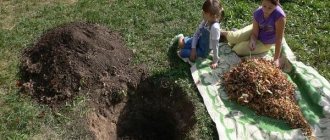Roses are capricious flowers that require careful care and favorable growing conditions. Thoughts about garden redevelopment periodically occur to gardeners, but fear about the plant’s reaction to this procedure prevents it from being carried out. If you follow all the transplanting rules, the rose bush will quickly take root in its new location and bloom profusely the next season.
Reasons for transplanting a rose to a new location
If, when planting, the design of the site was carefully thought out and all recommendations for caring for the plant were followed, there will be no reason to change its location. But there are other situations when it is necessary to transplant a rose to a new place:
- it was not possible to correctly plan the placement of plants in the flowerbed, the desire to use the area for another purpose;
- poor flowering due to poorly selected neighboring crops, nutrient deficiency;
- unsuitable soil: sandy, too loose soil contributes to the deepening of the root system, and clay soil, on the contrary, pushes it to the surface;
- non-compliance with growing conditions, temperature, humidity;
- lack of space to install a shelter for the winter;
- depletion of soil after growing a rose in one place for many years.
Roses are susceptible to lack of space; in such conditions they practically do not bloom and stop developing. In order not to have to replant an already mature plant, it is important to correctly calculate the place for its full growth.
Where to transplant a rose in the garden: choosing a place and soil
Garden roses are very demanding in terms of where they are grown, so for replanting (as well as for planting) you need to choose the most comfortable and suitable area. The survival rate of the plant in a new place and further cultivation and flowering depend on this.
The main requirements for a place for transplanting a rose: it should be well lit by sunlight, protected from wind and drafts (there should be no air stagnation). In this case, it is desirable that during the hottest afternoon hours the plants are in light shade.
It is very important to avoid swampy, waterlogged areas, for example, locations with high groundwater levels, lowlands in which water accumulates. When transplanted to such a place, the roots of the plant will certainly rot and the bush will die.
The soil for growing rose bushes must be fertile, loose, water- and breathable, and have neutral or slightly acidic acidity. Heavy, clayey, too dense soils, as well as too light, sandy soils are not suitable.
Advice! It is advisable to transplant the rose to a new place, which is similar in conditions to the old location. Thus, the bush will take root faster and easier.
Transplant timing
Experienced gardeners recommend planning to transplant adult overgrown roses in April before buds open or in the fall.
Optimal timing:
- Early spring, when the plant begins to awaken after wintering. But there is a risk that the roots will not have time to take root in the new area, the bush will become depleted and will delight you with flowering only next year.
- Summer, but only as a last resort. Carry out the procedure by choosing a cloudy, cool day, shortening the above-ground part. The plant has a chance to take root in a new place, but this will take a lot of time.
- Autumn is the ideal period for transplantation, since the shoots have already matured and the growth process is complete. Approximate dates: end of September – first ten days of October, 3 weeks before the onset of frost.
The time of transplantation must be selected independently depending on climatic conditions, region and the presence of compelling reasons.
Necessary preparation
The wrong location is one of the main reasons for replanting roses. This time, consider all the requirements of the plant:
- an open area or light partial shade (for varieties whose petals fade in the sun);
- fertile, loose, slightly acidic substrate;
- absence of reasons for stagnation of water (lowland) and/or groundwater close to the soil surface (1 m or less);
- protection from cold winds.
For long and abundant flowering, most roses need the longest possible daylight hours - keep this in mind when choosing a place for transplanted bushes
A planting pit with a depth and diameter of 0.5–0.7 m is prepared at least 2 weeks before the procedure. The easiest way is to fill it with purchased soil for roses, but you can prepare a soil mixture yourself from fertile turf, peat chips, humus, sand (2:1:1:1) and a liter jar of wood ash. At the bottom, a layer of drainage 5–7 m thick is required. A deoxidizer is added to acidic soil - dolomite flour or ground eggshells (100 g per hole), in alkaline soil - sawdust from coniferous trees (about a glass). It is not recommended to add mineral fertilizers when transplanting roses.
Drainage at the bottom of the planting hole will prevent water from stagnating at the roots of the rose - the plant is very sensitive to this, rot develops quickly
Plan the area of the site in advance if you are moving several bushes to a new location. The intervals between them depend on the size of the rose of a given variety. On average, 0.4–0.6 m is enough for hybrid tea, polyanthus and floribunda roses, 0.8–1 m for park roses, and 1 m or more for climbing and standard roses.
Selecting a new site
A good place for transplantation is an area where conditions are as close as possible to what they were before. This will help the plant adapt faster, avoiding severe stress.
Optimal characteristics of the new landing site:
- sufficient sunlight;
- shelter from northern winds;
- no drafts, but good circulation of fresh air;
- south oriented slope;
- loamy soil with an acidity level of 5.5 - 6.5 pH;
- The groundwater level is not less than 1.5-2 m.
Before transplanting, dig up the area to a depth of half a meter.
Preparing the hole for planting
Usually the hole for a new bush is prepared three weeks before planting it. It is not inferior in size to the hole from which the rose bush was removed. The hole is usually 60 cm in diameter and 45 cm in depth.
A rose, transplanted according to all the rules, will give you a wonderful flower that will become a real decoration of your garden.
The bottom needs to be loosened and the soil and compost sprinkled. Sprinkle regular soil on top to avoid burns to the roots of the bush. Before planting directly, the hole must be thoroughly watered.
Landing algorithm
There is a clear transplantation algorithm, regardless of the variety and variety of roses. If all steps are performed correctly, the young seedling or adult flower will quickly take root and adapt to new conditions.
Mature plant
Instructions for transplanting a formed adult rose:
- Site preparation. Dig a hole 50-60 cm deep, determine the diameter depending on the size of the roots. Prepare fertile soil to enrich the transplanted plant with nutrients by combining peat, sand and turf soil in equal parts. Pour the mixture into the hole, add organic fertilizers and leave for 2 weeks.
- Digging up a rose. Remove the root system along with the clod of earth. Start digging 30 cm away from the stem to maintain the integrity of the underground part. Carefully cut off the lateral shoots with a shovel, being careful not to touch the main tap root. To avoid damaging the plant during transportation, place it in polyethylene.
- Landing. Place the rose in the prepared hole so that the root collar is at ground level, and cover with fertile soil. Water generously and cover with a layer of soil.
- Mulching. Cover the tree trunk circle with sawdust, expanded clay or peat.
If the plant was replanted in the spring, pruning and additional care will be required. In the first year, the main task is to strengthen the root system, so it is worth cutting off the formed buds to focus on root growth.
Blooming rose
Not many people decide to replant a flowering plant. Since you will have to sacrifice luxurious flowering due to trimming the buds so that the nutritional elements are spent not on their formation, but on the growth and development of roots.
Instructions for planting a flowering plant:
- prepare a hole in a new area, fill it with fertile soil with compost and leave it for 2 weeks;
- remove all flowers and unopened buds from the bush;
- dig up the plant, after moistening the soil, trying to injure the roots as little as possible;
- pour a little water into the hole, install the rose, sprinkle with soil so that the root collar is 4 cm in the ground;
- compact the soil and water generously.
Replanting a bush to a new location during the flowering period is possible only as a last resort, following the planting technology and not sparing the young buds.
Curly wicker flower
The algorithm for transplanting a climbing rose does not differ from the basic scheme, but several important nuances need to be taken into account:
- at the end of flowering, pinch the tops of young shoots, and cut off old shoots that are more than 2 years old;
- remove the rose from the support and shorten the plants, the stem length should be 50-60 cm;
- carefully dig up the plant, trying not to damage the root system;
- transplant into a previously prepared hole;
- sprinkle with fertile soil and water generously.
Moving a climbing rose bush to a new location is labor-intensive; careful and rational pruning, careful transportation and proper planting will be required.
How to replant roses: digging, dividing and planting - step-by-step instructions
The transplant is carried out on a cloudy day or in the late afternoon to avoid the scorching sun.
Digging and replanting bushes with a lump of earth
The main thing is to carefully dig up the bushes so as not to damage the roots and preserve the earthen ball. Of course, you won’t be able to dig it up without damage, but the damage needs to be minimized.
Advice! First, the bushes must be shed with water so that the earthen ball does not fall apart during transplantation and adheres tightly to the roots. If it has recently rained and the soil is wet, then there is no need to water.
- The bush is carefully dug up from all sides around the perimeter, retreating 20-25 cm from the center of the trunk.
- Next, carefully pry up and pull out the bush with a lump of earth.
Important! If the rose was grafted onto a rose hip, it will have a long main root. It can be torn off, but the lateral roots must not be damaged.
- The seedling with the lump must be brought to a new place so that the earth does not crumble. (You can leave the seedling in a bucket, or better yet, in a bag or bag).
- The seedling is placed in a prepared planting hole with fertile soil.
Important! If the roses are not grafted, they are planted so that the root collar is at ground level.
- The grafted seedling is buried 3-5 cm into the soil.
- The hole is filled with soil and lightly compacted.
- Make a hole for watering around the trunk.
- Water generously with water, you can add a product for better rooting.
Advice! Do not skimp on water; the soil should cover the hole tightly so that there are no voids around the roots.
- If the soil settles, it must be replenished. The procedure of watering and adding soil is performed several times.
- At the end, the tree trunk circle is mulched with straw, wood chips or peat.
- The plantings are slightly shaded for 2 weeks (spunbond or gauze is pulled over the frame).
Maintaining the integrity of the root system
In order not to damage the integrity of the root system when digging, you need to follow certain rules:
- first dig around the bush, retreating 30-40 cm from the trunk;
- gradually expand the trench, reaching the base;
- Carefully chop off long roots with a shovel; with proper care after replanting, they will quickly recover;
- To carefully remove the roots, use a lever in the form of a crowbar: a shovel or wooden stick will not work, as they may break.
To safely transport the rose to a new place of growth, wrap the root system with cloth or polyethylene. You should not use a bucket; it may be difficult to remove the plant from it.
Transplantation process
At the initial stages of replanting, the gardener’s main task is to preserve the root system of the bush and cause minimal damage to it. Most bushes are moved to a new location directly with the lump of earth in which they grew until that moment. The main root is too deep, so there is no need to preserve it completely. This is especially true for grafted varieties, in which the main root can go deep into the ground up to 1.5 meters.
See also
Description and characteristics of Freedom roses, planting and care rulesRead
Transplant process:
- We irrigate the ground around the bush two days before moving to a new place.
- The shoots are carefully tied with a strong thread to facilitate access to the base of the bush.
- A trench is dug around the bush.
- Next, we go deeper into the ground, cutting off the overgrown roots with a shovel or other tool.
- The resulting lump of earth is placed in a plastic bag or thick film.
- We move the bush to a new place.
They dig a hole under a bush like this:
- in width it should exceed the diameter of the bush by 20 centimeters;
- in depth - 10 centimeters larger than the size of the earthen coma.
The bottom of the pit is covered with a layer of crushed stone, after which fertile soil is poured. Then a rose bush is lowered into the hole, after which the remaining volume is filled with earth. A properly planted plant adapts to a new location in three weeks. .
Dividing a rose bush during transplantation
Propagating roses by dividing an adult bush is the easiest and most reliable way. The transplantation process involves a clear algorithm of actions that should be followed in order to obtain healthy and hardy seedlings:
- dig up a rose, clean the roots from excess soil for ease of division;
- divide the bush with a knife or ax into several parts, each with a strong root and at least two annual shoots;
- dip the root system in dissolved clay, treat the damaged areas with copper sulfate or Fitosporin solution;
- prepare planting holes in advance by digging a hole depending on the size of the roots and pouring nutrient soil;
- Place the prepared seedlings in the hole, cover with soil and water generously.
Carrying out a transplant with division is a simple procedure; the main thing is to try to carefully dig up the bush, trying to preserve the integrity of the lateral roots and correctly divide the mother plant into full-fledged seedlings.
Why you need to replant roses: main reasons
Often roses grow strongly and interfere with the passage, etc. At the same time, the large shrub does not have enough nutrition, and it blooms poorly or dies. All this happens because the place for growing roses was chosen incorrectly or the flowers were planted at the wrong depth.
There are also external reasons why plants need to be replanted. For example, when you need to build something on this site or create a rose garden in another place on the site.
In addition, all perennial plants and especially shrubs must be replanted periodically.
Advice! When propagating roses by dividing the bush during transplantation, it is better to harvest cuttings in the fall.
Recommendations for caring for a transplanted flower
After transplantation, weakened plants need attention, careful care and timely implementation of all care procedures. Let's look at them in Table 1.
| Reception of agricultural technology | Necessary Requirements |
| Watering | Roses are distinguished by their deeply penetrating roots, which are able to absorb moisture from the lower layers of the soil. But after transplanting, you cannot do without watering until the underground system grows. For one bush you need to spend 3-4 buckets of water. Carry out the procedure once every 3 days early in the morning or in the evening at the root, avoiding moisture on the shoots |
| Weeding and loosening the soil | Weeds take away valuable moisture and nutrients from roses. Therefore, they need to be removed in a timely manner. To improve the absorption of moisture and oxygen, the top layer of soil should be loosened with a spatula or hand cultivator |
| Prevention | Carry out preventive treatments using safe means. Regularly inspect the plant for pests and disease symptoms. If they are detected, promptly take appropriate measures |
| Top dressing | The best organic fertilizer for roses after transplantation is manure. When replanting in spring, it is worth doing mineral fertilizing to restore the balance of minerals in the soil. |
| Trimming | Transplantation in spring or summer is accompanied by mandatory pruning. The stems need to be shortened by 20-30 cm, possibly more depending on the type of crop, trying not to affect the young shoots |
| Preparing for winter | Autumn replanting involves further preparation for frost. Sprinkle the base of the bush with earth in the form of a 15 cm hill, protect the trunk from cracking and damage by spruce branches. |
We also recommend watching the video with recommendations:
Beautiful and well-groomed roses are the dream of every gardener. To achieve the desired result, you must follow the rules for replanting the plant, carry out timely feeding, watering, pruning and other agrotechnical measures.
General rules for caring for roses in the open ground
The vast majority of varieties and varieties of roses do not have specific requirements for planting and care. A well-chosen site and adherence to the rules of planting and care are of great importance in growing a flowering crop.
Seat requirements:
- The site should be located on a hill, but if the rose grows in the lowlands, it will quickly disappear. The fact is that cold air flows stagnate there, and excess moisture accumulates, which contributes to root rot and the development of diseases.
- Roses are light-loving plants (the optimal daylight hours are 16 hours). They can grow in partial shade, but you definitely won’t be able to see abundant flowering; the bush will delight you only with its modest presence.
- Roses are afraid of drafts and gusts of wind. The area should be well ventilated, but protected from drafts.
- The plant develops only on fertile lands; the most suitable type of soil is chernozem and loam.
As for care, it includes regular and moderate watering, adding mineral and organic fertilizers to the soil, loosening and removing weeds, as well as mulching, sanitary pruning and preventing the development of diseases. It is recommended to replant the bushes at intervals of several years.
Rose care
Important! The most suitable time for planting and replanting roses is mid-spring or early autumn. Old bushes take root much worse than young ones, so it is necessary to create the most comfortable conditions for the plants.
Transplanting a climbing rose
Transplanting a climbing rose is considered to be quite difficult. As a rule, such an event is carried out in early autumn, but if necessary, replanting can be carried out in the spring, before the leaves bloom. It is mandatory to install support structures that will hold the plant and allow you to obtain the most decorative design. The root system should be dug in a circle, retreating from the bush approximately 35 cm
It is necessary to remove the soil from the dug-out root system with extreme caution and precision in order to carry out the following pre-planting preparation of the plant:
- soak the root system for a day in clean water with the addition of any rooting stimulant such as “Kornevin” or “Heteroauxin”;
- all weakened and non-viable, dry shoots need to be cut at a height of approximately 15-20 cm, which will stimulate the active growth of green mass;
- It is recommended to treat all sections of cuts with powdered charcoal to prevent the penetration of pathogenic microflora.
The depth of the pre-prepared planting hole should be at least 50-65 cm with a standard distance between plants of one meter. The root system, lowered into the planting hole, should be distributed as accurately and evenly as possible over the ground, without kinks. The root collar should be buried about ten centimeters into the soil.
Disadvantages of replanting bushes in summer
In summer you can also plant roses, but for this it is better to use container crops. Their root system remains intact and intact. They can be planted at any time, including in the summer. When moving a bush from one place to another, the buds must be cut off before transplanting. This is the main disadvantage of summer redevelopment of the flower garden.
If a rose bush is transplanted from one place to another, be sure to shade it. Roots damaged during transplantation will not be able to immediately take root and fully provide the plant with sufficient moisture on hot days. Therefore, the green leaves of a flower, as a rule, quickly fade, and its decorative properties decrease.
At any time of the year it is important to replant the flower correctly
Why do you need to transplant roses from one place to another?
Transplanting roses in the fall of 2022 will be painless if you transplant flowers following the rules of agricultural technology, guided by the recommendations of astrologers and the lunar calendar. Usually, bushes are replanted in order to save the flower crop. The plant should not be moved unless absolutely necessary. There are several reasons for replanting:
- Various diseases and lack of color can provoke the complete death of a flower crop. In such a situation, replanting will be a lifesaver for rose bushes.
- If neighboring plantings have become an obstacle to the full development of a garden rose, then their planting is simply vital for the plant.
- Deaf shading of plantings by trees and buildings has a detrimental effect on the growth of roses. Rose bushes require a lot of sun. Its absence provokes diseases.
- Mature bushes may stop flowering beautifully. The inflorescences will be small and lose their aesthetics. After changing the location, the flowering will again become lush and beautiful.
- It is urgently required to replant when the presence of groundwater is detected near the roots of the plant. This often occurs during flooding or excessive rainfall. Otherwise the roses will rot.
- If the soil in the garden area is depleted or has changed its composition, then “moving” to a new, specially prepared place will be a lifesaver for the flower.
On a note!
These are the main reasons for replanting, which require immediate action.
How to properly replant rose bushes: step-by-step instructions
To fully plant plants (so that they bloom for a long time and do not require a second replanting), you should follow simple recommendations:
- Decide on the transfer time.
- Prepare a new place for bushes. The soil in this area must be cleared of weeds and rhizomes. The hole is dug approximately 600 mm wide and 600-700 mm deep.
- It is important to prepare the rose before planting. Dried branches and buds are trimmed, and if the bush has grown excessively, it can be rejuvenated. It is also necessary to divide the roots.
- You need to take the rose out of the ground very carefully, without damaging the root system. Roses must be transferred with a clod of soil onto the rhizome.
- There is no need to deepen the roots into the finished hole. It will be good if the landing level remains the same. Tall flowers must be tied up to prevent them from breaking.
Frequently asked questions when transplanting roses
| Question | Answer |
| What to do if a transplanted rose withers? | Don't forget to keep the soil moist. It will be easier for the roots of the transplanted rose to take root in moist soil. When watering the soil around the rose, add root stimulants (Kornevin, Kornerost). The consumption rate is 1 g per 1 liter of water. You can pour about 5 liters of water under the bush. Treat the above-ground part of the plant with Epin or Zircon. These drugs are adaptogens with anti-stress effects. Consumption rate: 1 ampoule per 10 liters of water. |
| When can rose cuttings be transplanted? | Garden roses can be propagated by cuttings from the current and last year. A shoot 10-15 cm long is used as a cutting, from which all thorns are removed. The leaves from below are completely removed, and from above they are only shortened. Cuttings are prepared in the spring before flowering and in the fall when pruning the plant for the winter. Cuttings planted in spring can be left to overwinter in open ground. It is only recommended to cover them with agrofibre and leaves. It is better to keep cuttings rooted in autumn in the basement until next spring. And plant them in the garden, in open ground, in April. |
| Is it possible to replant a blooming rose (with buds)? | This can only be done with homemade roses of miniature varieties. Such a flower with buds can be transferred along with a lump of earth into a larger pot. This cannot be done with garden roses. You need to wait until the end of flowering, when 80% of the petals have fallen. |
| Is it possible to transplant a rose home for the winter? | If we are talking about indoor miniature varieties of roses that you planted in open ground for the summer, then you can replant them home for the winter. When it comes to street varieties of roses, this is strictly not recommended. Such bushes have a powerful root system that does not appreciate constant replanting. If you are afraid that a young bush will freeze during frost, then it is better to cover the rose for the winter. |
| When will the transplanted rose bloom? | If you transplanted a rose in the spring, it may bloom in the same summer. Flowering will not be abundant. But all experts advise not to allow flowering in the first year after transplantation. It would be better to cut off the buds that appear. This will help the plant grow its root system. And next summer you will enjoy lush flowering. |
| What soil should I transplant the rose into? | Rose prefers light, turfy soil with a slightly acidic environment. It is better to prepare a special soil mixture. To do this, you need to take neutral peat, compost, sand in equal proportions. It is advisable to add Vermiculite, Perlite or hydrogel to this mixture. This will reduce the frequency of watering. |
Preparing for autumn rose transplantation
Often the need to transplant a rose is due to the wrong choice of location. In order not to make a mistake a second time, consider the requirements of the flower:
- Good illumination - open space or light partial shade. There are very few shade-tolerant varieties of roses. But many varieties are also damaged by direct sunlight - the petals fade, the flowers quickly fall off. The ideal place for a bush is one where the sun illuminates it in the morning or late afternoon, and partial shade is established during the hottest time of the day.
- Availability of protection from cold drafts and sharp gusts of wind. All roses, without exception, do not like this. Plant the bush so that there is a natural or artificial barrier 3–4 m from it, on the south, east or southwest side of it. Climber roses are often protected by a support, but when transplanting from the fence, the walls need to be retreated by about 0.5 m, providing ventilation.
- A fertile but light substrate that allows water and air to pass through. Loam or sandy loam with a neutral or slightly acidic (pH 6.0–6.5) acid-base reaction is ideal. Roses will not take root in swampy, saline, clayey, rocky soil.
- Lack of close (1.5–2 m) groundwater approaching the surface. If moisture stagnates at the roots, they quickly begin to rot. For the same reason, roses are not suitable for lowlands, where melt and rainwater do not drain away for a long time, where moist cold air accumulates.
- Undesirable neighbors and predecessors are any Rosaceae. And these are not only other varieties of roses, but also many fruit and berry trees - cherry, apple, serviceberry, quince, bird cherry, peach, plum, apricot, almond. Roses are planted in the place where they grew after 5–6 years, not earlier. The reason is simple - plants draw the same nutrients from the soil and suffer from similar diseases and pests.
Popular articles Flowerpots in landscape design
Rose hole
A new planting hole is prepared 15–20 days before the procedure. Its dimensions depend on the type of rose. Miniature varieties need 30 cm in depth and diameter; climbers and powerful high scrubs require 80–90 cm. For other varieties, dig a hole 60–70 cm in width and depth.
Pebbles, expanded clay, ceramic shards, and brick chips can be used as drainage for roses.
Drainage is poured to the bottom. The minimum layer thickness is 7–8 cm. Then the hole is filled one third with the nutrient mixture. This can be purchased soil for roses in its pure form or a self-prepared substrate - turf soil, humus (or ready-made compost), peat chips, coarse sand (3:2:1:1) and store-bought fertilizer for roses without nitrogen content (150– 200 g). An alternative to complex fertilizer is 0.5 liters of wood ash and bone meal and 80–100 g of simple superphosphate.
It’s easiest to fill a planting hole with store-bought rose substrate, but if you need to replant several bushes at once, this already means significant expenses
The finished pit is covered with a piece of metal, slate, or roofing felt to prevent the soil from being washed away by rain. The day before planting, water the soil, filling the hole to the brim.
Digging up an adult bush
Digging up a rose is one of the most difficult moments in replanting it. To make your task easier, water the bush generously. After waiting 2-3 days, if possible, tie the shoots and dig around the plant approximately to the diameter of the crown. If the stems are very thorny, wrap them in cloth. For climbers, the lashes must first be removed from the support and trimmed, shortening them to about 1.5–2 m.
It is most convenient to replant roses at the age of 2–3 years, their dimensions allow this
Please note that grafted roses have a powerful taproot that extends a meter or less into the soil, while self-rooted roses have a superficial root system that actively grows in breadth. Based on this, in the first case you need to dig at least 50–70 cm deep, and in the second - wider than in the first. The main task is to preserve the roots as much as possible. Although, of course, it cannot be done without damage.
The presence of a powerful taproot is noticeable even in grafted rose seedlings
The dug up bush is picked up with a pitchfork or a crowbar and loosened, as if trying to pull out a baby tooth. Some of the roots are trimmed. The rose removed from the soil, together with a lump of earth, is transferred to a piece of dense fabric or durable polyethylene. Branches that break during the process must be pruned. It is not recommended to touch other shoots - it is from the aboveground part that the rose will draw nutrients to form new roots (the only exception is climbers).
Any bush (including rose bush) that you want to replant is removed from the soil, prying it up with a shovel, crowbar, or pitchfork.
Rose seedlings waiting to be planted and adult bushes before transplanting can be dug in for preservation.











